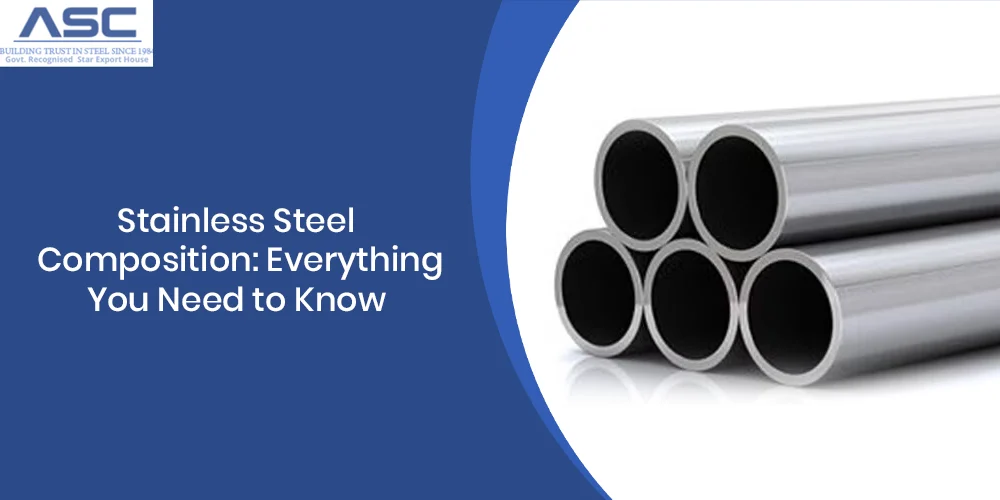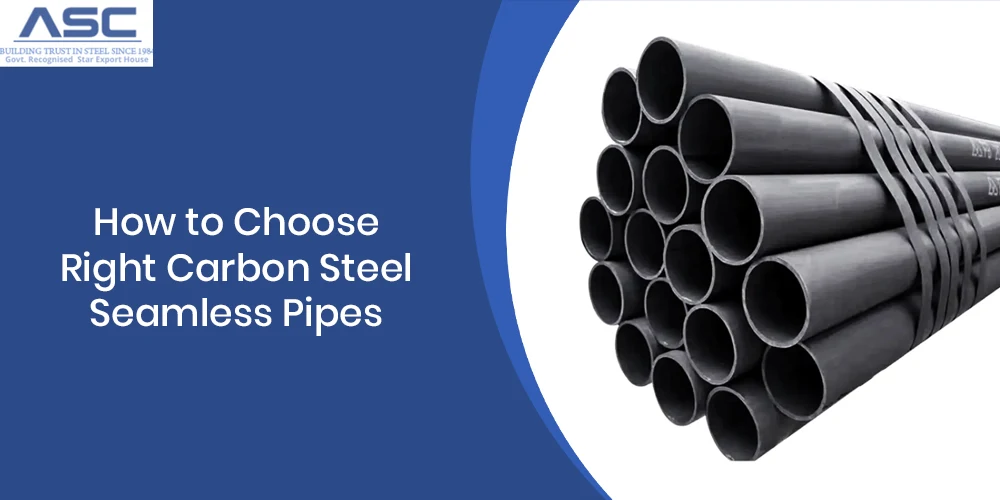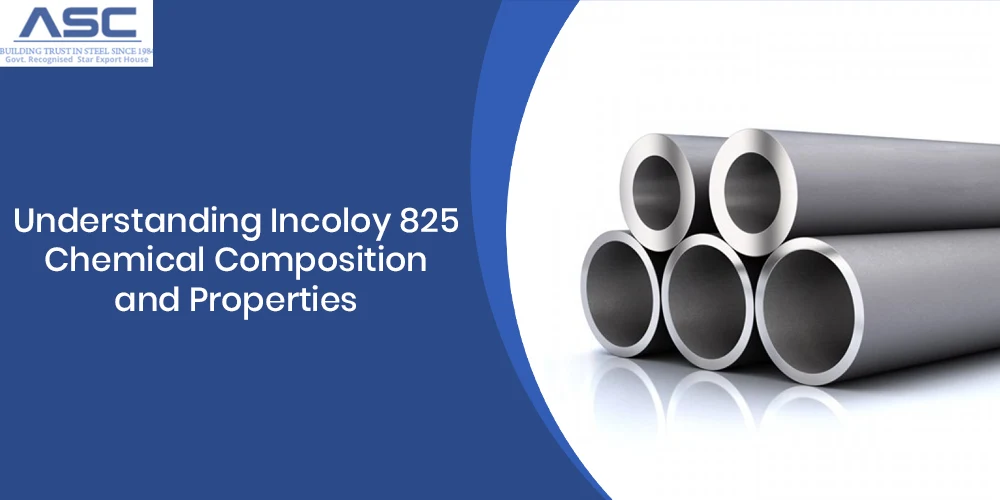Stainless Steel Composition: Everything You Need to Know
by AMC
Posted on April 08, 2025 at 05:01 PM

Modern industries use stainless steel as their base material because it provides both excellent strength and corrosion resistance and durability and appealing looks. The combination of stainless steel elements including iron, chromium, nickel, molybdenum and other substances produces these properties. Stainless steel achieves its diverse usage across buildings of every height and medical tools and home appliances because of its exact component equilibrium.
Amardeep Steel Centre operates worldwide by producing and distributing stainless steel products to various industries through its superior quality offerings. This blog examines stainless steel composition and discusses different grades and demonstrates how steel compositions impact actual-world functionality.
What Is the Composition of Stainless Steel?
Stainless steel starts with iron and chromium at minimum 10.5% because this chromium content gives corrosion protection. The alloy contains chromium as its main element with other components added to the mixture, such as:
- Nickel
- Molybdenum
- Carbon
- Manganese
- Nitrogen
- Silicon
- Titanium
Each unique property of stainless steel components makes it suitable for diverse end applications. The selection process for appropriate stainless steel grades in industries requires knowledge of composition requirements that range from medical devices to oil refineries.
Key Alloying Elements in Stainless Steel
Chromium – Corrosion Resistance
Stainless steel exists as its basic form because of chromium. Stainless steel forms a protective oxide layer on its surface when chromium content reaches above 10.5% thus blocking oxidation and corrosion. Chromium stands as the fundamental element in stainless steel composition because of its direct link to corrosion resistance and acid and environmental durability.
Nickel – Strength & Ductility
Nickel strengthens stainless steel through its ability to enhance both flexibility and strength and toughness. Nickel stabilizes the austenitic structure that exists in stainless steel grades 304 and 316. Stainless steel maintains its structural integrity through easy shaping processes that become possible when subjected to extreme temperatures.
Molybdenum – Enhanced Durability
Molybdenum provides structures built near ocean waters with resistance against corrosion attacks found in chloride-rich environments. The addition of molybdenum enables stainless steel to preserve its strength and formability properties when heated to high temperatures. The 316 stainless steel material demonstrates this particular characteristic.
Carbon, Manganese & Other Elements
- Carbon adds strength and hardness. Stainless steel becomes stronger as carbon levels increase but its resistance to corrosion decreases. The material serves its most important function in martensitic grades which are used for blade and cutting tool applications.
- The combination of manganese achieves material deoxidation while providing enhanced material strength. Stainless steel producers can replace nickel components in cost-effective stainless steel grades through manganese additions
- Small quantities of Nitrogen, Silicon and Titanium improve resistance to intergranular corrosion and weldability and grain refinement properties.
| Element | Percentage Range | Element | Percentage Range |
|---|---|---|---|
| Iron | 50-72% | Manganese | 1-2% |
| Chromium | 16-30% | Silicon | 0.5-1% |
| Nickel | 8-10.5% | Nitrogen | Up to 0.1% |
| Molybdenum | 2-3% | Phosphorus | ≤ 0.045% |
| Carbon | 0.03-0.08% | Sulfur | ≤ 0.03% |
Different Grades of Stainless Steel & Their Composition
Stainless steel grades receive their classification through two main factors which include microstructure type and alloy composition. The most popular stainless steel families each contain unique alloy compositions of stainless steel.
Austenitic Stainless Steel (304, 316, etc.)
- Grade 304: Grade 304 represents the most common stainless steel type because it contains 18% chromium and 8% nickel. The material works well for applications in food equipment production as well as architectural cladding and engineering projects.
- Grade 316: Grade 316 incorporates 16% chromium together with 10% nickel and 2% molybdenum. The alloy composition includes 16% chromium and 10% nickel and 2% molybdenum which provides increased chloride resistance for chemical processing and marine applications and pharmaceutical applications.
These grades are non-magnetic, corrosion-resistant, and offer excellent formability.
Ferritic Stainless Steel (430, 409, etc.)
- Grade 430: Grade 430 features 16-18% chromium alongside low carbon content. This stainless steel grade finds its primary applications in household appliances together with automotive trims.
- Grade 409: Grade 409 features 11% chromium content and good weldability which makes it suitable for automotive exhaust systems and structural applications.
Ferritic steels are magnetic, lower in cost, and offer moderate corrosion resistance.
Martensitic & Duplex Stainless Steel
- Martensitic Grades (e.g., 410, 420): The Martensitic Grades including 410 and 420 contain elevated carbon levels which allow heat treatment for achieving hardness properties. The material finds applications in knives as well as turbines and valves.
- Duplex Grades (e.g., 2205, 2507): The duplex grades including 2205 and 2507 combine austenitic-ferritic structures which provide two times more strength than 304 steel and excellent stress corrosion cracking protection. These grades are ideal for oil & gas and marine industries.
How Stainless Steel Composition Affects Its Properties
Strength, Hardness & Ductility
- Carbon and manganese increase hardness.
- Nickel improves ductility and toughness.
- Martensitic steels (high carbon) can be hardened through heat treatment.
- Austenitic steels offer superior tensile strength and workability
The balance between these elements determines how suitable the material is for mechanical stress, wear, and formability.
Corrosion Resistance & Heat Tolerance
- Chromium offers general corrosion resistance.
- Molybdenum enhances protection against chloride attacks.
- Nickel boosts performance in high-heat or acidic environments.
Selecting the right stainless steel composition based on the service environment ensures longevity and reduced maintenance costs.
Applications of Stainless Steel in Various Industries
Construction & Architecture
Used in
- Railings, cladding, and façades
- Bridges and public infrastructure
- Reinforcement in concrete (rebar)
Stainless steel provides aesthetics, structural strength, and resistance to weather and pollution.
Automotive & Aerospace
Used in
- Exhaust systems (Grade 409/439)
- Trim and structural components
- Aircraft hydraulic lines and engine parts
It reduces weight, resists oxidation at high temperatures, and maintains strength under dynamic conditions.
Medical & Food Processing Equipment
Used in
- Surgical instruments (Grade 420)
- Food-grade surfaces and storage tanks (Grade 304/316)
- Pharmaceutical clean rooms and lab equipment
Its hygiene, non-reactivity, and ease of cleaning make it essential in these sectors.
Why Understanding Stainless Steel Composition Matters
Using an inappropriate grade selection will cause premature material failure and create both safety hazards and replacement expenses. For example:
- The substitution of 304 stainless steel for 316 stainless steel in coastal environments will increase the risk of pitting corrosion.
- The use of an improper duplex grade for high-pressure offshore applications will likely cause stress corrosion cracking.
Engineers and procurement professionals who recognize stainless steel compositions can select appropriate grades that fulfill specific application needs related to resistance, strength or economic requirements.
At Amardeep Steel, we help clients select appropriate stainless steel grades through comprehensive project analysis of environmental conditions and mechanical requirements and operating temperatures.
Conclusion: Choosing the Right Stainless Steel Grade
The composition of stainless steel serves as the essential basis that determines both operational excellence and extended durability and economical value. The behavior of steel in real-world conditions depends directly on the percentages of chromium, nickel, molybdenum and carbon.
Stainless steel composition percentage serves as a key factor for selecting the appropriate grade when building bridges or manufacturing food-grade machinery or designing medical instruments.
At Amardeep Steel Centre, we provide expert guidance together with quality materials and a wide selection of stainless steel grades to customers. Contact our team to obtain custom recommendations together with high-performance stainless steel products that fulfill your business requirements.

How to Choose Right Carbon Steel Seamless Pipes
The successful operation of industries under routine pressure and heat and mechanical stress depends on choosing appropriate Carbon Steel Seamless Pipe.

